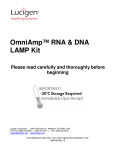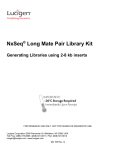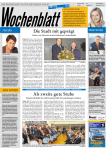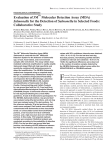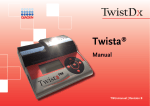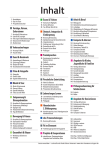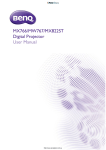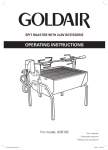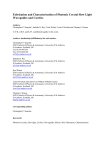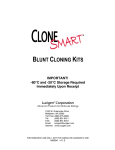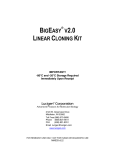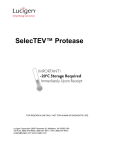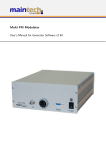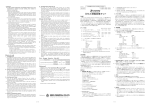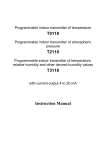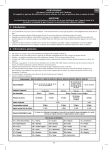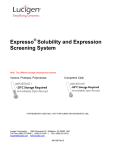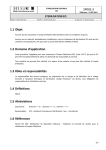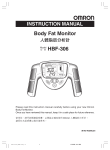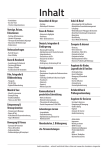Download SP003-OmniAmp-Supplemental Protocol
Transcript
OmniAmp™ RNA & DNA LAMP Kit Supplemental Protocol This protocol is recommended for use with the ESEQquant TS2 real-time isothermal amplification device (QIAGEN Lake Constance GmbH) FOR RESEARCH USE ONLY. NOT FOR HUMAN OR DIAGNOSTIC USE. 1 SP003 Rev. A Table of Contents Table of Contents ................................................................................................................................. 2 Technical Support ................................................................................................................................ 2 Product Description ............................................................................................................................. 3 Product Designations and Kit Components ..................................................................................... 3 Components and Storage ................................................................................................................... 4 Material to be Supplied by the User ................................................................................................... 4 Before you start.................................................................................................................................... 4 Reaction Setup ..................................................................................................................................... 4 Target-Specific Optimization.............................................................................................................. 6 Experimental Reaction: ...................................................................................................................... 6 Control Reaction ................................................................................................................................ 5 Isothermal Amplification Conditions .................................................................................................. 7 LAMP Reaction Optimization .............................................................................................................. 7 Step 1: Magnesium and Betaine Concentration ................................................................................ 7 Step 2: Temperature Optimization ..................................................................................................... 8 Other optimization notes .................................................................................................................... 8 Reaction time and temperature ..................................................................................................... 8 Enzyme Concentration .................................................................................................................. 8 Primer Concentration ..................................................................................................................... 8 Dye ................................................................................................................................................. 8 Dilution buffer ................................................................................................................................. 8 Additional Amplification Guidelines ................................................................................................ 9 Avoid Ribonuclease (RNAse) Contamination.................................................................................... 9 Cold Reaction Set-Up ........................................................................................................................ 9 Template Preparation ........................................................................................................................ 9 Reaction Overlay ............................................................................................................................... 9 dNTP’s ............................................................................................................................................... 9 Dye for quantitation ............................................................................................................................ 9 References ............................................................................................................................................ 9 Qiagen Workflow Information: ......................................................................................................... 10 Appendices ......................................................................................................................................... 11 Appendix A: Examples of Target-Specific and Nonspecific LAMP Amplification............................ 11 Appendix B: LAMP Resources ........................................................................................................ 11 Appendix C: Quality Control Assays................................................................................................ 12 Appendix D. Notice of Limited Label License, Copyright, Patents, Warranties, Disclaimers and Trademarks ...................................................................................................................................... 13 Technical Support Lucigen is dedicated to the success and satisfaction of our customers. Our products are tested to assure they perform as specified when used according to our recommendations. It is imperative that the reagents supplied by the user, especially the RNA specimens to be amplified, are of the highest quality. Please follow the instructions carefully and contact our technical service representatives if additional information is necessary. We encourage you to contact us with your comments regarding the performance of our products in your applications. Lucigen Technical Support: Email: [email protected] Phone: (888) 575-9695 2 SP003 Rev. A Product Guarantee: Lucigen guarantees that this product will perform as specified for one year from the date of shipment. Please avoid using reagents for greater than one year from receipt. Lucigen does not guarantee the performance of the the QIAGEN Lake Constance solutions. For technical questions on the the QIAGEN Lake Constance products, contact QIAGEN Lake Constance Technical Support: [email protected] For information on QIAGEN Lake Constance solutions, visit www.qiagen.com/ESE Product Description The OmniAmp™ RNA and DNA LAMP Kit is intended to simplify development of LAMP reactions for detecting RNA or DNA. LAMP is a commonly used isothermal amplification system that was developed and patented by Eiken Chemical Co. (see Appendix D). This kit may be used for research purposes only, under the limited-use license described at the end of this document. Details of the LAMP reaction and its use can be found in the References section or Appendix B: LAMP Resources. OmniAmp DNA polymerase is unique in having both reverse transcription and strand-displacing activities. This rare and powerful combination enables LAMP detection of either DNA or RNA targets. Other isothermal amplification techniques that rely on strand displacement may also be possible with OmniAmp reagents, however they are not tested. LAMP commonly employs a set of six primers, which must be supplied by the user. Lucigen recommends using previously-established designs, or designing new primer sets using the Eiken web utility (see Appendix B: LAMP Resources). Not all primer sets identified by this program are guaranteed to perform with OmniAmp or any other enzyme system. It is recommended that two or three primer sets be designed and compared experimentally. We highly recommend inclusion of loop primers (Nagamine, 2002). LAMP amplification may be detected by agarose gel electrophoresis, turbidity (Mori, 2001), or by using double-stranded DNA binding fluorescent dyes. Product Designations and Kit Components Product OmniAmp™ RNA & DNA LAMP Kit Kit Size 100 Reactions 500 Reactions Catalog number 30065-1 30065-2 Reagent Description OmniAmp DNA Polymerase, 50X 10X DNA Polymerase Buffer C Magnesium Sulfate 100 mM Betaine, 5 M RNA Control I LAMP Primer Mix, 10X Nuclease-free Water Positive Control OmniAmp DNA Polymerase, 50X Part Numbers Volume F831942-1 50 µL F881958-1 1 mL F98695-1 1 mL F881901-1 1 mL F812344-1 20 µL F98698-1 F823398-1 1 mL 20 µL F831942-1 5 x 50 µL 3 SP003 Rev. A 10X DNA Polymerase Buffer C Magnesium Sulfate 100 mM Betaine, 5 M RNA Control I LAMP Primer Mix, 10X Nuclease-free Water Positive Control F881958-1 5 x 1 mL F98695-1 5 x 1 mL F881901-1 5 x 1 mL F812344-1 5 x 20 µL F98698-1 F823398-1 5 x 1 mL 5 x 20 µL Components and Storage Store all kits and components at -20 C Material to be Supplied by the User dNTP mix, 25 mM each 20X EvaGreen® Dye (Biotium). Target-specific 10X LAMP Primer mix (Common formulation: 16 µM FIP and BIP primers, 8 µM Loop-F and Loop-B primers and 2 µM F3 and B3 primers) Target RNA or DNA Reaction Setup Before you start 1. Always wear gloves while handling the components. 2. Verify sufficient volume of kit components required for planned reactions prior to setup. 3. Set up and protocol described below is using real time thermocycler. If using a heat block, replace amount of dye with Nuclease-free H2O. 4. Make sure that the ESEQuant TS2 is set to desired temperature and acticate channel 470/520. We recommend using the following off-the-shelf tubes with the ESEQuant TS2: a. VWR: PCR strip with attached Optically Clear Cap, volume 0.2 mL color natural, Cat No: 211-2613 b. 4titude 4ti-0790 0.2 mL Single Tube, flat cap 4 SP003 Rev. A 5. RNase free environment and procedures should be used to avoid contamination. 6. Add target in an area separated from the area where the reaction mix is prepared. 7. Thaw reagents and set up reactions on ice. 8. Reaction setup should be done using good laboratory techniques that minimize cross contamination. Note: First-time users are strongly encouraged to perform the control reaction as described below (Table 1) in order to ensure successful results with LAMP and the OmniAmp system. Control Reaction Table 1 Final Concentration or Quantity Volume, µL Nuclease-free H2O -- 13.95 10X DNA Polymerase Buffer C 1X 2.5 800 µM 0.8 100 mM MgSO4 8 mM 2.0 5 M Betaine 0.15 M 0.75 0.4X 0.5 LAMP Primer Mix, 10X 1X 2.5 OmniAmp DNA Polymerase, 50X 1X 1.0 1 -- 1.0 Component dNTPs 20X Dye Positive Control Total volume 1 25 Positive control can be used at dilutions from 1:5 to 1:500 with reliable results Workflow: In order to minimize cross-contamination, steps 6 and 7 should be done in an area separate from area where you are preparing reaction mix. 1. Thaw all kit components and hold on ice. 2. All components should be mixed well before use. Vortex all tubes for 10 seconds then centrifuge briefly to collect. 3. Prepare the reaction mix as shown in Table 1 in the order listed. Add all the components except the template (Positive Control). During this step the reaction mix tube should always be held on the ice to prevent background activity of enzyme. 4. Once all reagents have been added, mix the reaction completely. This step is required to ensure uniform distribution of all reaction components. 5. Dispense 24 µL of reaction mix in a PCR tube or 96-well PCR plate for each reaction. 5 SP003 Rev. A 6. On ice, prepare 1:5 dilution of Positive Control by combining 1 µL of it with 4 µL of Nucleasefree Water. 7. Add 1 µL of the 1:5 diluted Positive Control to each well/tube. 8. Cap tubes or seal plate wells. Centrifuge briefly to collect prior to incubation. 9. Place tubes into into the ESEQuant TS2 instrument and start run at 70 °C for 30 minutes, using channel 470/520 for detection. 10. Incubate at 70 °C for 30 minutes. 11. If required, run samples on a 2% agarose gel. Note: Reactions may be kept at -20 °C for longer term storage. Target-Specific Optimization OmniAmp polymerase is provided with Polymerase Buffer C, which is designed to support LAMP and other isothermal amplification processes. Buffer C contains all components required for amplification, including Magnesium Sulfate (MgSO4) at 2 mM final concentration. However, certain targets and amplification systems will require optimization using the included MgSO4 and Betaine supplements. For more information on optimization, see LAMP Reaction Optimization section below. For most targets, optimization of Magnesium and Betaine concentrations will result in shorter time to result and reduced background amplification. (See Appendix A: “Examples of Target-Specific and Nonspecific LAMP Amplification”) Experimental Reaction: Final Concentration or Quantity n/a Component Nuclease-free H2O 10X DNA Polymerase Buffer C 1 Volume, µL Recommended Concentrations To 25 1X 800 µM (recommended) 1 2 - 12 mM 1.0 – 2.0 8 mM (2 µL) 0.1 - 0.5 M 0.5 – 2.5 0.15 M (0.75 µL) 0.4X 0.5 Target-Specific Primer Mix , 10X Variable Variable 1X OmniAmp DNA Polymerase, 50X 1X - 2X 0.1 - 2.0 1X (1 µL) 0.01ng – 100 ng Variable dNTPs (25 mM each) 2 100 mM MgSO4 5 M Betaine Dye, 20X 3 Template RNA or DNA Total volume 1. 2.5 0.8 25 Buffer C is prepared with low magnesium (2 mM final) to allow optimization. However, most LAMP systems will require a final MgSO4 concentration of 6 mM or greater. 6 SP003 Rev. A 2. 3. It is strongly recommended to use dNTPs that have not undergone multiple freeze-thaw cycles. LAMP systems are more sensitive to dNTP quality than typical PCR systems, so fresh dNTP’s are recommended for applications where sensitivity and reproducibility are important. Please see Appendix B: LAMP Resources for information on LAMP Primer design. Note: If a dye is added for amplification quantitation, use between 0.2 µL and 1.0 µL per reaction, or other per the manufacturer’s recommendations. Excessive amounts of dye will interfere with or inhibit the reaction. Isothermal Amplification Conditions The following general program is recommended: Step 1. Amplification 2. Hold 1. Temperature 68 ˚C – 72 ˚C 4 ˚C Time 20 - 35 Minutes1 ∞ The amplification threshold is usually reached in 8-20 minutes, depending on template concentration. However, long reactions can lead to undesired background. Please see the optimization notes below on reaction time. For additional amplification guidelines please go to page 9. LAMP Reaction Optimization Lucigen recommends optimizing reaction conditions in two separate steps. In the first step, determine the optimal Magnesium and Betaine concentrations. In the second step, use that buffer formulation identified in step 1 over a range of temperatures to find the condition with the best overall performance. Step 1: Magnesium and Betaine Concentration Magnesium and Betaine concentrations can be easily optimized using an array of reactions run in parallel. For best results, use a 96-well plate in a calibrated thermocycler. For buffer optimization work, perform all reactions at 68 °C. Note: Polymerase Buffer C already contains MgSO4 at 2 mM, which is not sufficient for most reactions. Therefore most reactions will require supplemental magnesium sulfate. Use of buffers other than Buffer C provided in this kit is not recommended Note: To allow more precise adjustments for individual reactions, the stock 5 M Betaine solution can be diluted to 1 M using nuclease-free water. Using these suggested increments in a matrix of conditions, it should be possible to quickly find an approximately optimal reaction formulation. More precise optimization can be done in subsequent steps if needed. 7 SP003 Rev. A Step 2: Temperature Optimization After the optimum buffer composition has been established, determine the best temperature for your targets by performing the reaction at a range of temperatures. For most targets the optimal reaction temperature is between 66 °C and 72 °C. Reaction temperatures above 72°C or below 66 °C are not recommended. Note: Higher reaction temperatures generally provide faster amplification, but may also result in increased background (non-specific) amplification. Other optimization notes Reaction time and temperature LAMP and other isothermal amplification processes are prone to spurious amplification if the reactions are allowed to proceed for too long or if they are run at too high a temperature. Therefore, during optimization it may be necessary to reduce time and temperature from apparently optimal conditions in order to avoid unwanted background amplification or decreased specificity. Reaction times of 30 minutes or less are strongly recommended. This is true of reactions with the target present as well as of no-template controls. Enzyme Concentration As with time and temperature, the use of more enzyme may result in better amplification results. Using the enzyme at up to 2X concentration may increase the reaction speed or sensitivity, however it can also lead to increased background amplification. Primer Concentration Depending on the primer-template system, it may be necessary to optimize primer concentration after the optimum reaction condition has been identified. Certain primer systems may be prone to background amplification at or near the commonly used LAMP primer concentrations. If undesired background amplification is observed, a primer concentration titration (down to 0.2X of the original primer concentration) should be performed. The concentration of all primers should be adjusted in unison, preferably by using varying amounts of a stock of the primer mix. Increasing primer concentration will generally lead to increased background amplification and is therefore not recommended. Reducing the primer concentration may reduce sensitivity and reaction yield, or it may increase the time required to amplify your target. Dye It is recommended to use EvaGreen® dye, however, users are free to use any fluorescent dye suitable for use in real time PCR. However, in such case optimization to determine required concentration of dye to be used in LAMP reaction will be needed. Dilution buffer Preparation of target dilutions in 25 mM Tris (pH 8.0) usually helps in increasing sensitivity especially for RNA targets. When using Tris as dilution buffer, it is very important to adjust pH to 8.0 (+ 0.1) and filter the solution. Prepared solution can be stored at room temperature, however for long-term storage and to avoid contamination, it is recommended that solution should be aliqouted and stored at 4 °C. 8 SP003 Rev. A Additional Amplification Guidelines Avoid Ribonuclease (RNase) Contamination Major sources of RNase contamination in a typical laboratory include solutions and reagents, environmental exposure and contact with human hands and skin. Avoid introducing RNases, rather than trying to remove them. Some basic precautions must be taken to work successfully with RNA. Always wear gloves to prevent introducing RNase contamination from human hands. Change gloves frequently especially after touching skin, door knobs, and common surfaces. Use a set of pipettors dedicated solely for RNA work. Use RNase-free plasticware and reagents. Designate an RNAse-free area of the lab. Cold Reaction Set-Up The OmniAmp polymerase has residual activity above 4 °C that can cause non-specific background amplification at temperatures below specific reaction temperature of 66 to 72 °C. All reactions using OmniAmp Polymerase should be set up on ice and maintained at 4 °C prior to amplification. Primers should be added just prior to target addition and incubation. Template Preparation Most routine methods of template purification are sufficient (e.g. phenol/chloroform or guanidine/silica-based methods). However, trace amounts of purification agents (phenol, EDTA, Proteinase K, ethanol, etc.) may inhibit amplification. It is preferred that the nucleic template be dissolved in water or EDTA-free buffer rather than TE following purification. If TE is required, formulation with 0.1 mM EDTA will give best results. Reaction Overlay A thermal cycler with a heated lid is ideal to prevent evaporation of the reaction mix. If no such lid is available, the reaction mixture can be overlaid with one-half reaction volume of PCR-grade mineral oil. This may slow the reaction. dNTP’s For best results, or when sensitivity or reproducibility are critical, use a stock of dNTP’s that have not undergone multiple freeze-thaws. LAMP systems can be more sensitive than PCR to the quality of dNTP’s. Dye for Quantitation If you intend to add a reagent for quantitation of the reaction or measurement of its progress, be aware that excessive dye may inhibit the reaction. Conditions will vary and will require optimization, but dye should be used at or below common working concentrations. References Notomi T, Okayama H, Masubuchi H, Yonekawa T, Watanabe K, Amino N, Hase T. Loopmediated isothermal amplification of DNA. Nucleic Acids Res. 2000 28(12):E63. 9 SP003 Rev. A Nagamine K, Hase T, Notomi T. Accelerated reaction by loop-mediated isothermal amplification using loop primers. Mol Cell Probes. 2002 16(3):223-9. Mori Y, Nagamine K, Tomita N, Notomi T. Detection of loop-mediated isothermal amplification reaction by turbidity derived from magnesium pyrophosphate formation. Biochem Biophys Res Commun. 2001 289(1):150-4. Mori Y, Hirano T, Notomi T. Sequence specific visual detection of LAMP reactions by addition of cationic polymers. BMC Biotechnol. 2006 6:3. Tomita N, Mori Y, Kanda H, Notomi T. Loop-mediated isothermal amplification (LAMP) of gene sequences and simple visual detection of products. Nat Protoc. 2008 3(5):877-82. QIAGEN Lake ConstanceProduct Information: SpeedXtract Nucleic Acid Kit: https://www.qiagen.com/gb/about-us/contact/oem- services/ese-instruments/speedxtract-nucleic-acid-kit/ ESEQuant TS2: https://www.qiagen.com/gb/about-us/contact/oem-services/eseinstruments/esequant-ts2/ For more information on Qiagen solutions contact: QIAGEN Lake Constance GmbH Jacques-Schiesser-Str. 3 78333 Stockach Germany Tel: +49-7771-91660 Fax: +49-7771-9166218 E-mail: [email protected] 10 SP003 Rev. A Appendices Appendix A: Examples of Target-Specific and Nonspecific LAMP Amplification Correct target-specific amplification. Figure 1: Lane 1: 100 bp Marker, Lane 2: Negative LAMP reaction. Lane 3 and Lane 4: Positive LAMP reaction products from an RNA Control I template. A distinct banding pattern is seen among the smear. Figure 2: Lane 1: 100 bp ladder, Lane 2 and Lane 3: Background Amplification in a LAMP reaction. Non-specific or Background amplification appears as a single continuum of fragments with no visible or indistinct bands. A prominent primer dimer band is also characteristic of non-specific amplification. Lane 4: Negative LAMP reaction. Appendix B: LAMP Resources 11 SP003 Rev. A Eiken PrimerExplorer Software: The Eiken PrimerExplorer software is an online software application that will assist users in designing a LAMP primer set. The software can be accessed at the URL listed below. For convenience, the user manual for this software has been published online as well. PrimerExplorer link: http://primerexplorer.jp/elamp4.0.0/index.html Primer Explorer manual pages 1 through 10: https://primerexplorer.jp/e/v4_manual/pdf/PrimerExplorerV4_Manual_1.pdf Primer Explorer manual pages 11 through 34: https://primerexplorer.jp/e/v4_manual/pdf/PrimerExplorerV4_Manual_2.pdf Primer Explorer manual pages 35 through 68: https://primerexplorer.jp/e/v4_manual/pdf/PrimerExplorerV4_Manual_3.pdf Appendix C: Quality Control Assays Activity Assay Polymerase activity is assayed at 72 °C with 0.2 mM each of dATP, dGTP, dTTP, dCTP (mix of unlabeled 33 and [ P] dCTP); 10 µg activated calf thymus DNA, and 0.1 mg/mL BSA. Absence of Endonuclease OmniAmp Polymerase is determined to be free of detectable endonuclease or nicking activity. One µg of supercoiled plasmid DNA is incubated with enzyme for 16 hours at 70 °C. Agarose gel electrophoresis shows no alteration in mobility, consistent with endonuclease or nicking activity. Absence of Exonuclease OmniAmp Polymerase is tested to be free of contaminating exonuclease activity by incubating 1 µg of Hind III-digested lambda DNA with enzyme at 70 °C for 16 hours. Agarose gel electrophoresis shows no alteration in mobility, consistent with exonuclease activity. Absence of Ribonuclease OmniAmp Polymerase is tested to be free of contaminating RNAse activity by incubating with a fluorogenic RNAse substrate for 1 hour at 37 °C. No increase in assay fluorescence above background is detected. Functional Assays OmniAmp Isothermal Amplification system is tested for performance by isothermal amplification of regions of the MS2 bacteriophage RNA genome and the E. coli DNA genome. The resulting amplification products are visualized on ethidium bromide-stained agarose gels. 12 SP003 Rev. A Appendix D. Notice of Limited Label License, Copyright, Patents, Warranties, Disclaimers and Trademarks Copyright 2013 by Lucigen Corp. All rights reserved. Lucigen and OmniAmp are registered trademarks of Lucigen Corp. Lucigen’s products are sold for research use only and are not to be used in humans or for medical diagnostics. Lucigen’s liability with respect to any OmniAmp product is limited to the replacement of the product. No other warranties of any kind, expressed or implied, including without limitation, any implied fitness for any particular use, are provided by Lucigen. Lucigen is not liable for any direct, indirect, incidental or consequential damages arising out of or in connection with the use or inability to use any of its products. Some applications in which Lucigen enzymes can be used may be covered by other patents issued and applicable in the United States and certain other countries. Because purchase of this product does not include a license to perform any patented application, users of this product may be required to obtain a patent license depending upon the particular application in which the product is used. It is the sole responsibility of the buyer to ensure that use of the product does not infringe the patent rights of third parties. Limited Label License The OmniAmp DNA Polymerases is covered by patents assigned to Lucigen Corporation. Patent Applications WO 00/28082, WO 01/34790, and WO 01/77317 regarding the LAMP method are owned by the Eiken Chemical Co. Ltd. OmniAmp™ is sold by Lucigen under license for use in LAMP for research use only. Lucigen does not encourage or support the unauthorized or unlicensed use of third party intellectual property. It is the sole responsibility of the buyer to ensure that use of the product does not infringe the patent rights of third parties. If the purchaser is not willing to accept these use limitations, Lucigen Corporation is willing to accept return of the product for a full refund. For information on obtaining a license to use this product for purposes other than those permitted above, contact Lucigen Corporation, 2905 Parmenter St., Middleton, WI 53562. Email: [email protected]. Phone: 608-831-9011. Fax 608-831-9012. The consideration paid for this product grants a Limited License to use the product pursuant to the terms set forth in this Limited Label License. Academic, Not-for-Profit and For-Profit institutions acquire certain limited nontransferable rights with the purchase of this product (see below). By use of this product, you accept the terms and conditions of the Limited Label License. The purchase price of this product includes limited, nontransferable rights to use only the purchased amount of the product and only as described in the Kit Instruction Manual. This limited license specifically excludes manufacture of OmniAmp DNA Polymerase or any derivatives thereof. The buyer cannot modify this product for any purpose without express written consent of Lucigen Corp. Lucigen Corporation reserves all other rights; in particular, the purchaser of this product may not transfer or otherwise sell this product or its components or derivatives to a third party, and no rights are conveyed to the purchaser to use the product or its components or derivatives for commercial purposes. The buyer may transfer information or materials made through the employment of this product or its components to a scientific collaborator, provided that such transfer is not for commercial purposes, and that such collaborator agrees in writing (a) not to transfer such materials to any third party, and (b) to use such transferred materials and/or information solely for research and not for commercial purposes. “Commercial purposes” includes any activity for which a party receives consideration and may include, but is not limited to, (1) use of the product or its components or derivatives in manufacturing, (2) use of the product or its components or derivatives for diagnostic purposes, (3) use of this product or materials made therefrom to provide a service, information, or data to a third party in return for a fee or other consideration, or (4) resale of the product or its components or derivatives, whether or not such product or its components or derivatives are resold for use in research. Lucigen Corporation will not assert a claim of infringement against the buyer of this product provided that none of this product, or any of its components, or any claim in the foregoing patent or patent applications was used in the manufacture of a product for commercial purposes. Academic, Not-for-Profit, and For-Profit institutions must obtain a separate license from Lucigen Corporation to use this product for any purpose other than those permitted above. 13 SP003 Rev. A













